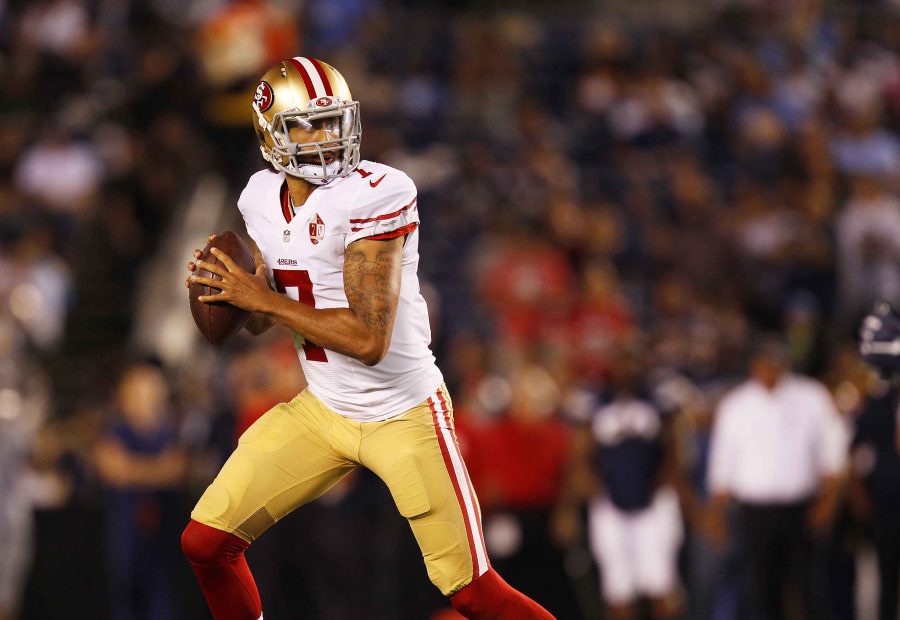How the 49ers protests emulate civil rights figures, prompt discourse
San Francisco 49ers quarterback Colin Kaepernick scrambles against the San Diego Chargers in the second quarter during a preseason game on Thursday, Sept. 1, 2016, at Qualcomm Stadium in San Diego. (K.C. Alfred/San Diego Union-Tribune/TNS)
September 20, 2016
The protest movement against racial injustice and police brutality initiated by San Francisco 49ers quarterback Colin Kaepernick gained additional supporters Sunday afternoon during the team’s latest pre-game ceremony.
Four more 49ers took a seat during the national anthem in North Carolina in Week 2, as athletes across the country have put the pre-game ceremony into the spotlight since Kaepernick announced he would not stand for a country that oppresses people of color. The sit-down demonstrations have sparked discourse of social reform and prompted others to question whether the national anthem and American flag represent all Americans.
While Kaepernick’s tactics have dominated news headlines as of late, the measures are nothing new.
Advertisement
During the 1968 Summer Olympics, gold and bronze track and field medalists Tommie Smith and John Carlos stood with their heads bowed and fists raised as the American National Anthem played during the victory ceremony representing the civil rights movement. The iconic moment fortified a symbol of the struggle for civil rights in American history.
Tiffany Player, an SIU professor in Civil War History, said the act of protesting is a part of living in America.
“It’s a form of freedom of speech,” Player said of famous athletes who have brought the issue of social injustice to the forefront of conversation. “It’s an expression of their American identity.”
She added that demonstrations of so-called civil disobedience have been used throughout history by people of color to question America’s loyalty to them.
“Malcolm X and the Black Panthers criticized the traditional government and the symbols of the flag because it wasn’t a representative of the experience of African Americans,” Player said.
Player said “The Star-Spangled Banner” — written in 1814 by Francis Scott Key — wasn’t supposed to include women, Native Americans or African Americans. African Americans weren’t considered people, Native Americans were being stripped of their land and women weren’t able to vote.
Key was imprisoned in Maryland when he wrote and used the poem for whites who were vulnerable and saw hope when a glimpse of the flag appeared from the ceils. But when the song was written, Player said, it only pertained to white male citizens.
Advertisement*
“Before the war, white, male citizens weren’t united because of disputes over the new colonies,” Player said. “And after having a common enemy, which was Great Britain, it made white, male citizens unite.”
Meanwhile, while some choose not to participate in the protest, they still understand it and remain patriotic.
Jefferson Vea, an SIU football player from Orlando, Fla., whose parents are from Haiti, said he wouldn’t participate in the protest, but he understands the message.
“I feel like it’s a respect thing,” Vea said. “Even though my parents aren’t from America, I still say it.”
Staff writer Tyra Wooten can be reached at [email protected] or on Twitter @twootenDE.
To stay up to date with all your southern Illinois news, follow the Daily Egyptian on Facebook and Twitter.
Advertisement










Dayna Wooten • Sep 22, 2016 at 6:17 pm
That is the greatest thing about America..our freedom of speak. Without that we have nothing. Much respect for the young man because that took courage to stand up for the rights and justice of others. As for the American flag I feel everyone is in titled their own opinion…who are we to judge. Excellent article it really makes you wonder if all “American” stood up for the rights of others, no matter the color of skin, shape, and hair texture where would we be today?
TS Alexander • Sep 22, 2016 at 10:33 am
Well written and thought provoking. I am hopeful the dialogue will continue and a resolution is found.
Lillian Ackles • Sep 22, 2016 at 9:59 am
The article was well written. It’s inspiring to me because it is a subject that should be at the forefront of our minds. Our society is in need of a wake up call. Respect for each other and human lives is what matters. I admire this young man for his peaceful yet resoundingly Loud protest.
God Bless America
Ken Ackles • Sep 21, 2016 at 9:45 pm
It is the right of all Americans to voice their opinions . He has chosen to voice his peacefully, and publicly. May God continue to bless and keep this young man safe. Awesome work, by the talented staff writer. Keep reporting the topics that inspire us to think about our actions!
Lindsey Massey • Sep 21, 2016 at 9:31 pm
I respect the pledge. No matter it’s original purpose, it has become a symbol of pride and hope for this nation. Call me a fool but I believe that. I respect the athletes right to protest. Something has to be done . Laws have to to be rewritten and cops who gun down civilians should be punished.
We must remember as Americans we hold the power. In November we must vote for those we feel can make a positive change.
Aaron Wiley • Sep 21, 2016 at 1:10 pm
As a black man I don’t think the song should be played at sporting events and expect black people to stand for it, you wouldn’t ask police to stand for Ice Tea’s song F. the police would we